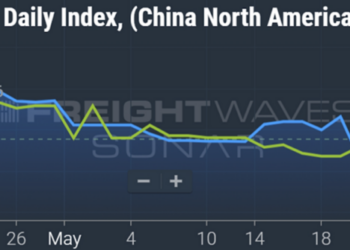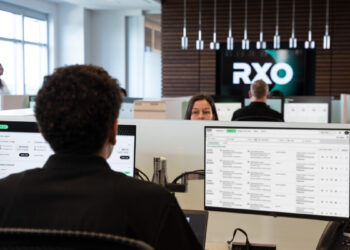The already competitive market for ocean freight and vessel tracking and communication is about to have another integrated maritime management platform vying for the coveted box.
SITA, the company behind the air transport industry’s IT solutions on passenger portfolio for airports and digital travel is hoping to replicate its success in the friendly skies in the maritime industry. The new company, SmartSea, was created between SITA and an initial agreement with Columbia Shipmanagement (CSM), the world-class ship manager and maritime service provider. CSM is also SmartSea’s first client.
In an exclusive interview before he sat down with main stakeholders at Posidonia, SmartSea CEO Julian Panter sat down with American Shipper to make his case as to why this latest solution should become the industry standard.
AMERICAN SHIPPER: SITA is hoping to replicate its language buildout in the air sector into the maritime sector. What markets are you looking at making your mark to be used as an example of using SITA tech and development in the maritime value chain?
PANTER: One of the most obvious opportunities is the cruise industry. SITA should be able to ensure a seamless experience for fly/cruise customers. But to be honest, the strategic intent is far wider than that.
SITA is taking a bold step into the maritime sector, where their longstanding leadership in aviation can serve to overcome economic and capacity challenges, enhance security, and unlock new revenue streams for companies across the whole industry. The global maritime industry plays a vital role in fostering economic growth, human development and global connectivity. By facilitating international trade, creating jobs and driving technological innovation, the industry contributes to better living standards and economic prosperity globally. SmartSea is in a privileged position to revolutionize the maritime digital ecosystem, providing a one-stop shop for maritime technology solutions and becoming the market leader in maritime technology by implementing solutions trusted by most of the global air travel industry.
SITA sees the opportunity to implement technologies that are already helping airlines, airports and governments to offer seamless travel experiences to passengers across the world while improving operations.
AMERICAN SHIPPER: Is this technology platform already developed? How quickly can this technology be ramped up in willing marketplaces?
PANTER: Much of SITA’s technology is already ready for maritime. SITA already has contracts with companies such as Hapag-Lloyd, where it is adding value to its shore-based business. SITA is also working with an Asian-based cruise terminal in which it is installing contactless biometric gates traditionally used in airports.
These are just two examples of SITA’s intent to move into the maritime space. The real USP will be the data backbone, which will be ready by early in 2027 and will facilitate systems from different organizations to converse with one digital language as in aviation.
Alongside developing the data backbone, which will be the glue that sticks many parts of the digital ecosystem together, it is worth explaining that SmartSea is already operational across three business units: firstly the transferring of SITA technologies to vessels, alongside utilising existing partners in the maritime technology sector across areas such as cybersecurity, connectivity, navigation communications and data analytics, all of which will add immediate value to vessel operators, owners and managers.
Business unit two will focus on the development of a new integrated maritime management platform and also our continued work on an existing software management platform called AMOS.
Finally, SmartSea is ready to offer a complete IT outsourcing solution to our clients who are looking for shore-based IT services. In fact, we have just secured our first major information technology outsourcing (ITO) contract with Columbia Shipmanagement, who are one the top five ship management companies in the world.
AMERICAN SHIPPER: You mentioned how Hapag-Lloyd is already a client. How will you fold in this technology for their ocean business?
PANTER: SITA has been working with Hapag-Lloyd’s shore-based IT systems to enhance efficiencies, improve security, and SITA is always looking for ways to add value to one of the most prominent clients. SmartSea will use this case study and the wonderful testimonials from Hapag-Lloyd’s leadership as a way of demonstrating to other maritime clients that we have the backing of the correct experts from SITA who have provided previous support to one of the world’s leading shipping companies.
AMERICAN SHIPPER: The maritime sector is highly fragmented, and there are investment hurdles. You have a readership here who are potential stakeholder targets. Make a conscientious, quick case on why SITA should be part of their solution.
PANTER: SmartSea is the industry’s first company with the power to reshape the maritime sector by facilitating access to the same advanced technology that has already transformed the air transport industry. With this strategic step, SITA is embedding its transformative footprint into the maritime industry, breaking boundaries and simplifying processes for more efficient and profitable operations across the entire value chain.
With 75 years of experience, SITA serves 95% of international destinations in the air travel industry and over 2,500 airlines, airports, ground handlers and governments all working closely with the company. More than 70 governments and all G20 nations trust SITA solutions, and 85% of international air passengers benefit globally from SITA digital border solutions. SITA’s undeniable role in transforming the air industry and shaping it into what it is now is the strongest proof of the value SITA can provide to the maritime sector.
AMERICAN SHIPPER: This is a long-game — what will you consider a meaningful buildout and in how many years?
PANTER: We want to unify the industry, bring stakeholders together and create a digital platform which the whole of the industry can operate through in a safe, efficient and secure manner. SITA has been successful in aviation because it works with other technology firms, all of the airlines, airports, governments, governing bodies and logistics firms.
The strategy of SmartSea is to create a similar platform and community in maritime which will allow the whole industry to become safer, more efficient, technologically advanced and more sustainable. I believe that other industries will see maritime becoming the front-runner in technology rather than always being perceived to be lagging. This will only happen if we all come together and collaborate, communicate and join forces.
AMERICAN SHIPPER: How many millions of dollars of investment to create this backbone?
PANTER: The exact investment is difficult to pinpoint because of continued time to customize, adapt and improve over the next couple of years, but the budget is in the tens of millions of dollars, so it’s a considerable investment in time, software development and consulting services.
AMERICAN SHIPPER: What is your message to the International Maritime Organization?
PANTER: The reason that SITA has been so successful in aviation is because of the support of the governing bodies in the industry. The IMO can open the opportunity to bring key stakeholders from different areas of the sector together to create a more efficient digital world in the industry.
For example, some of the technology used in aviation has also improved areas of sustainability, such as SITA’s flight path optimization software used by planes. That software is widely reported to be more effective than the same software used for the voyage optimization in shipping, and if we can bring it to maritime, we can further optimize voyages to reduce emissions.
Technology in general will improve safety, data, efficiency and sustainability in the maritime sector, and SmartSea has bought the number one technology company from aviation (SITA) to maritime. It is willing to let us transfer any of the technology it has from aviation to our wonderful industry, so let’s not waste this chance.
I encourage IMO to meet myself and SITA leadership so we can talk about developing a committee to look at what can be done to ensure we make the most of this opportunity. SmartSea can be a company that all stakeholders in maritime can be part of; in aviation SITA has a diverse board composition from all areas of the aviation sector to ensure collaboration, joined up thinking and synergy.
AMERICAN SHIPPER: There are many technologies out there. What makes this technology better and different than the technologies being pushed out now?
PANTER: SITA has developed software across the whole value chain in aviation, from airports, planes and borders. SmartSea will be SITA’s platform to do the same in maritime.
SmartSea isn’t interested in creating one or two technologies for a segment of the industry in one specialist area, but rather create an ecosystem across the whole value chain which allows other technology companies to integrate as well. For SmartSea, it’s about creating one platform which all stakeholders can use to ensure one digital language for quicker and more efficient operations.
AMERICAN SHIPPER: What are the gaps you are identifying in the maritime sector, and how do you build value in those areas?
PANTER: SITA’s expansion into maritime is clear evidence of its ambition and capacity to boost digital innovation in a sector that, facing similar challenges, can be greatly enhanced by solutions for the air transport industry, estimated to be 10-15 years ahead in terms of technology adoption.
Both the maritime and aviation sectors operate in a complex and highly regulated ecosystem globally, are capital-intensive, heavily reliant on data and communication while also facing very similar sustainability requirements.
Moreover, ports and ship terminals experience the same challenges and opportunities; vessels require turnaround and maintenance, the same as aircraft, and both need to manage crew, passengers, baggage and freight efficiently and with constrained budgets. SmartSea can serve to overcome economic and capacity challenges, enhance security and unlock new revenue streams for companies across the industry.
AMERICAN SHIPPER: Have you been able to quantify the value for users of this platform? How much money can be saved in the industry if this technology is used?
PANTER: It is difficult to quantify this exactly because of the uptake in its utilization.
AMERICAN SHIPPER: Would this solution be more feasible in the cruise sector versus the container/bulk/ tanker markets?
PANTER: SmartSea will work across the whole industry: ports, cruise terminals, cruise operators, mega-yachts, commercial vessels, office/shore-based operations and commercial ports.
As some examples, SmartSea will leverage the experience SITA has at Heathrow Airport, which has ITO services.
Maritime organizations would have complete ITO service for their offices. We can implement biometric technology into shipyards to track workers entering the facilities. The advanced technologies in aviation used to track luggage or goods being exported can be used in commercial ports. The software used in planes which provides data points for predictive maintenance can be inserted into commercial ships, and obviously the link between cruise ships and airlines and airports is an obvious opportunity.
AMERICAN SHIPPER: You are working with Cruise Saudi. How is this buildout going?
PANTER: Cruise Saudi is a great client for SmartSea. Cruise Saudi understands that the future of cruise travel must be technologically advanced, which aligns with the overall vision of Saudi Arabia’s Vision 2030. Cruise Saudi is the perfect partner for SmartSea because it is embracing the chance to leverage technology from the aviation sector, which it realizes is more advanced and ahead of what has traditionally existed previously, hence the chance to offer passengers, crew and other stakeholders a better experience.
AMERICAN SHIPPER: What is the end game? Where can this technology realistically go and in what time frame?
PANTER: The end game is for ports to talk with ships, ships to talk with shore-based offices, cruise lines to interact with airlines and airports, logistics firms to connect with shipping. Imagine a world in maritime where everyone is connected!
The post SITA looking to replicate air industry success in the maritime industry appeared first on FreightWaves.













